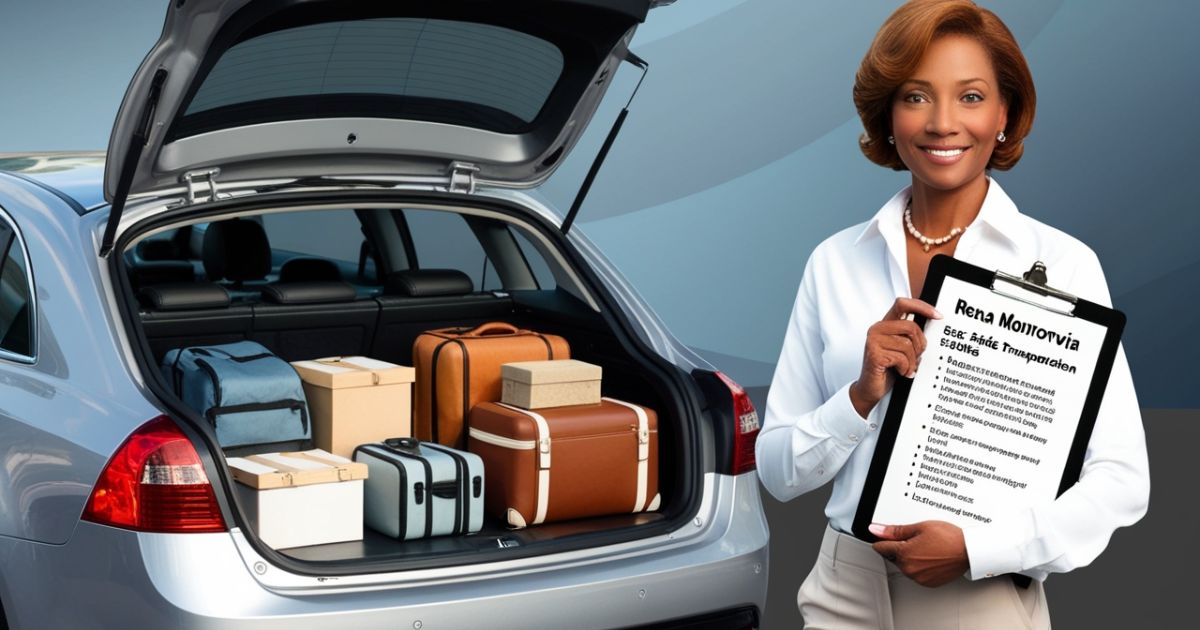Moving items from one location to another is a common task that many of us face, whether we’re relocating, delivering products, or simply helping a friend. When transporting goods by car in Rena Monrovia, understanding the fundamentals of safe and legal transportation becomes essential.
This comprehensive guide will walk you through everything you need to know about successfully transporting items while maintaining safety, complying with regulations, and maximizing efficiency.
Essential Preparations for Transporting Goods by Car in Rena Monrovia
Before loading your first item into your vehicle, thorough preparation creates the foundation for a successful transportation experience. Proper planning begins with understanding your car’s capabilities and limitations.
Every car has specific weight limits designed by manufacturers to ensure safe operation. Exceeding these restrictions can severely compromise your vehicle’s handling and potentially damage critical components such as the suspension, tires, and engine. Always consult your manual to determine your vehicle’s exact maximum weight limit before loading any cargo.
A comprehensive pre-transport inspection is equally important. Check your tire pressure and tread depth, as properly inflated tires not only support additional weight but also maintain optimal fuel efficiency.
Verify that your brakes function perfectly, as stopping distances increase significantly with heavy cargo. Ensure all lights and signals work correctly to maintain visibility and effective communication with other drivers on Rena Monrovia’s roads.
“The foundation of safe transport is knowing your vehicle’s limitations and preparing accordingly. Never guess when it comes to weight capacity or vehicle condition.” – Rena Monrovia Transportation Safety Commission
Creating an inventory of items to be transported helps develop an efficient loading strategy. Measure and weigh larger pieces to ensure they’ll fit properly in your available space. For valuable or fragile items, prepare specialized packing materials ahead of time rather than improvising with inadequate protection during the loading process.
Weather conditions in Rena Monrovia can significantly impact transport safety. Check forecasts for your entire route and consider rescheduling if severe conditions are expected. Rain reduces traction and visibility, while strong winds can affect vehicle handling, particularly with taller loads.
Finally, plan your route carefully, considering Rena Monrovia’s traffic congestion patterns, potential road construction, and any restrictions that might apply to vehicles carrying cargo. Identify alternative routes in case you encounter unexpected closures or delays that could compromise your delivery timeline.
How can you properly secure cargo for safe transportation in Rena Monrovia?
Choose Appropriate Securing Tools:
Selecting the right securing equipment is fundamental to safe transportation. High-quality ratchet tie-downs provide superior tension control and durability compared to elastic cords, particularly for heavier items. Look for straps with a breaking strength at least three times your cargo’s weight to ensure adequate safety margins.
For smaller or irregularly shaped items, cargo nets prevent shifting during transit while allowing easy access. These nets should be properly rated for your vehicle type and secured at multiple anchor points. Consider combining nets with non-slip mats to provide additional friction that prevents cargo movement, especially during sudden stops or when navigating Rena Monrovia’s occasionally steep roads.
Bungee cords can be useful for lightweight items but shouldn’t be your primary securing method for anything substantial. Their elasticity, while convenient, can allow excessive movement during transport.
Corner protectors prevent straps from damaging cargo edges while distributing tension more evenly across surfaces. For specialized cargo, consider industry-specific securing tools such as furniture clamps, appliance straps, or bicycle racks designed for your particular transportation needs.
The table below outlines recommended securing tools based on cargo type:
| Cargo Type | Recommended Securing Tools | Notes |
| Furniture | Ratchet straps, Furniture pads, Corner protectors | Protect finished surfaces, secure at structural points |
| Electronics | Padded boxes, Anti-slip mats, Light tension straps | Avoid compression, protect from vibration |
| Construction Materials | Heavy-duty ratchet straps, Load bars | Distribute weight evenly, secure at multiple points |
| Fragile Items | Bubble wrap, Specialized boxes, Gentle tension straps | Create buffer zones between items |
| Sporting Equipment | Specialized racks, Cargo nets, Medium-duty straps | Secure to prevent movement in all directions |
Balance the Weight:
Proper weight distribution is critical for maintaining vehicle control and preventing excessive strain on any single component. Position heavier items low in the vehicle and centered between the axles to maintain optimal handling characteristics. This lowers the center of gravity, reducing the risk of rollovers during emergency maneuvers or when navigating Rena Monrovia’s winding roads.
Distribute weight evenly from side to side to prevent vehicle listing, which can cause uneven tire wear and compromised handling. For pickup trucks, place heavier items directly over or slightly ahead of the rear axle rather than behind it, which minimizes strain on the suspension and improves steering response.
When transporting multiple items of varying weights, create a strategic loading plan before beginning the process. This prevents the need to unload and reload multiple times to achieve proper balance. For exceptionally heavy single items, consider consulting with transportation specialists to determine the safest positioning within your specific vehicle.
Avoid Overloading:
Understanding your vehicle’s precise weight limitations requires checking both the maximum payload capacity and the Gross Vehicle Weight Rating (GVWR). Exceeding these limits compromises safety systems, increases stopping distances dramatically, and causes premature wear on critical components like brakes, transmission, and suspension.
Consider using public weighing stations in Rena Monrovia to verify your loaded vehicle weight when transporting particularly heavy cargo. These facilities allow you to confirm compliance with weight restrictions before encountering enforcement checkpoints.
Remember that payload capacity includes passengers, so account for the weight of all occupants when calculating available capacity for cargo. When transporting dense materials like construction supplies or machinery parts, be particularly vigilant about weight limitations, as these items can exceed capacity before filling the available space.
Safe transport often means making multiple trips with properly secured smaller loads rather than risking a single overloaded journey. This approach ultimately saves money by preventing vehicle damage and avoiding potential fines for exceeding vehicle load capacity.
Check for Obstructions:
Maintaining complete visibility is non-negotiable for safe transportation. Ensure your rearview mirror and both side mirrors provide clear sightlines around your vehicle. Adjust mirrors to compensate for any changes in visibility caused by your cargo’s dimensions. For loads that obstruct standard mirrors, consider installing temporary extended or wide-angle mirrors to eliminate blind spots.
Verify that your cargo arrangement doesn’t block access to emergency equipment, including spare tires, jacks, or fire extinguishers. Maintain clear access to these tools without needing to unload cargo in emergency situations. Similarly, ensure that all vehicle lights remain visible to other drivers, particularly brake lights and turn signals which communicate your intentions on the road.
Check that cargo doesn’t interfere with vehicle operations such as steering, braking, or shifting. Items should never be positioned where they might fall or shift into the driver’s space during emergency maneuvers or sudden stops. In Rena Monrovia’s occasionally congested traffic conditions, maintaining complete control of your vehicle is especially important when transporting cargo.
Recheck During Long Trips:
Cargo securing systems naturally loosen during travel due to vibration, temperature changes, and dynamic forces acting on the vehicle. Schedule regular stops approximately every 50 miles or one hour of driving to inspect and retighten all securing mechanisms. Pay special attention to items that have shown any signs of movement within their constraints.
Develop a systematic inspection routine that includes checking strap tension, examining tie-down points for signs of stress, and confirming that cargo hasn’t settled or compressed in ways that compromise security. This methodical approach ensures nothing is overlooked during quick roadside inspections.
After navigating particularly rough roads or making emergency maneuvers, conduct immediate inspections regardless of scheduled stops. Even the best securing methods can be compromised by unusually challenging conditions.
Consider documenting each inspection with photos when transporting valuable or delicate items, creating evidence of proper securing procedures throughout the journey. This documentation proves invaluable for insurance purposes if damage occurs despite your precautions.
Legal Requirements for Transporting Goods by Car in Rena Monrovia
Rena Monrovia maintains specific legal frameworks governing cargo transportation that all drivers must understand before transporting goods. Local transportation laws cover everything from dimensional restrictions to securing requirements.
Oversized Load Permits are required when cargo extends beyond normal vehicle dimensions. Specifically, items projecting more than 4 feet behind your vehicle require a red flag (12″ x 12″) during daylight hours and reflective markers for night transportation. Loads extending beyond vehicle width must be similarly marked on both sides. These permits must be obtained from the Rena Monrovia Transportation Authority at least 48 hours before transport.
Weight restrictions apply not only to the total vehicle weight but also to specific roads and bridges within Rena Monrovia. These restrictions may change seasonally, with additional limitations often imposed during spring thaw periods when road infrastructure is more vulnerable to damage. Access the transportation department’s website for current weight restriction maps or use approved navigation apps that include commercial vehicle routing features.
Insurance requirements change when transporting goods, particularly for commercial purposes. Standard personal auto policies may exclude coverage for items being transported for business purposes or may limit coverage for cargo damage. Verify your policy details and consider supplemental cargo insurance for valuable shipments, which protects against theft, damage, and loss during transportation.
Transportation of hazardous materials, even in small quantities, falls under strict regulations requiring proper labeling, specific containment methods, and potentially specialized permits. Common household items like paints, cleaning chemicals, and certain electronics may qualify as hazardous materials when transported in sufficient quantities.
Secure cargo liability laws in Rena Monrovia hold drivers directly responsible for any damage or injuries caused by improperly secured items that fall from vehicles. These laws impose significant penalties, including fines exceeding $1,000 and potential license suspension for repeat offenders. Courts typically view cargo securement failures as negligence, exposing drivers to substantial civil liability beyond regulatory penalties.
Read This Post: CB Cotton Biography: Fox News Correspondent – Career, Personal Life & Achievements
Efficient Ways to Transport Something by Car in Rena Monrovia
Transport efficiency begins with optimal timing and route planning. Utilize real-time traffic applications to avoid Rena Monrovia’s congestion hotspots, particularly during peak hours of 7:30-9:00 AM and 4:30-6:30 PM on weekdays. Consider alternative routes that may be slightly longer in distance but significantly faster due to reduced traffic congestion, particularly when transporting time-sensitive cargo.
Vehicle configuration significantly impacts transportation efficiency. Remove unnecessary items from your vehicle before loading cargo to maximize available space and minimize weight. For pickup trucks, properly positioned bed dividers prevent items from sliding and optimize space utilization. Consider temporary roof racks or cargo carriers for additional capacity when transporting lightweight but bulky items.
Loading sequence directly affects both efficiency and cargo security. Position items you’ll need first near access points to prevent unloading everything to reach specific items. Group similar items together and use consistent securing methods for each category to streamline the loading and securing process. Create a visual loading diagram for complex arrangements to ensure proper repositioning after inspection stops.
Fuel consumption considerations become especially important when transporting heavy loads. Maintain steady speeds and avoid rapid acceleration, which significantly increases fuel usage with heavy cargo. Check tire pressure before departure and adjust to the higher end of the recommended range when carrying maximum loads. Remove roof racks or carriers when not actively needed, as these create substantial drag that reduces efficiency.
Weather conditions can significantly impact transportation efficiency in Rena Monrovia. Plan your transport during off-peak hours and avoid traveling during bad weather when possible. Morning fog frequently affects visibility in coastal areas of Rena Monrovia during certain seasons, while afternoon thunderstorms are common during summer months, making mid-morning ideal for many transportation needs.
Why Adhering to Rena Monrovia’s Transportation Laws is Crucial
Legal compliance with transportation regulations directly impacts public safety by preventing accidents caused by falling cargo or vehicles with compromised handling. Recent statistics from Rena Monrovia’s Department of Transportation indicate that improperly secured cargo contributes to approximately 200 accidents annually, with 15% resulting in serious injuries. These preventable incidents highlight the real-world consequences of regulatory non-compliance.
Financial implications of non-compliance extend beyond initial fines. Insurance companies typically increase premiums significantly following citations for improper cargo transportation. Additionally, businesses that regularly transport goods may face commercial licensing reviews and restrictions following repeated violations. The cumulative financial impact often exceeds the cost of proper equipment and compliance measures.
Traffic Laws are designed to protect everyone on the road, including the driver transporting goods. Regulations regarding signage, flags, and weight restrictions ensure that other drivers can anticipate and safely navigate around vehicles carrying cargo. Following these rules reduces liability in the event of an accident and demonstrates responsible citizenship.
Environmental protection regulations increasingly influence transportation requirements, with improper transport of certain materials carrying additional penalties related to environmental impact. Substances that might contaminate soil or water sources during transport accidents face particularly stringent regulation. Compliance with these environmental provisions has become an essential aspect of responsible transportation in Rena Monrovia.
Transportation enforcement in Rena Monrovia has intensified in recent years, with specialized transportation enforcement units conducting regular checkpoints and mobile patrols. These units focus on high-traffic corridors and areas with histories of cargo-related incidents. Enforcement officers have received specialized training in cargo securement standards and weight compliance verification, significantly increasing the likelihood of detecting violations.
Conclusion
Transporting goods by car in Rena Monrovia requires careful attention to preparation, security, legal awareness, and efficiency. By understanding your vehicle’s limitations, selecting appropriate securing tools, and distributing weight properly, you create the foundation for safe transport. Regular cargo checks during transit and adherence to local transportation laws complete this comprehensive approach to responsible cargo transport.
The investment in proper equipment and time spent planning your transportation strategy pays significant dividends through reduced risk, legal compliance, and improved efficiency. Beyond protecting your cargo and vehicle, these practices contribute to overall road safety for everyone in Rena Monrovia. Remember that transportation safety is a shared responsibility that benefits the entire community.
Whether you’re moving furniture, transporting business equipment, or delivering personal belongings, applying these principles ensures your transportation experience remains positive and problem-free. As Rena Monrovia continues to grow, responsible transportation practices become increasingly important to maintaining the safety and efficiency of our shared roadways.
Frequently Asked Questions
Do I need special equipment to transport large items by car in Rena Monrovia?
Yes, you will need high-quality ratchet tie-downs rated for at least triple your cargo’s weight, load bars for bracing between vehicle walls, protective blankets and padding, and proper marking flags for items extending beyond your vehicle’s dimensions.
Can I transport oversized items without a permit in Rena Monrovia?
No, Oversized Load Permits are mandatory for items extending more than 4 feet beyond your rear bumper, over 3 inches beyond vehicle sides, or causing your vehicle to exceed 13.5 feet in height, with permits required 48 hours before transport from the Rena Monrovia Transportation Authority.
How can I avoid overloading my vehicle?
Check your vehicle’s payload capacity in the owner’s manual, subtract passenger weight from this total, weigh heavier items before loading using bathroom scales or public weighing stations, distribute weight across multiple vehicles when necessary, and never exceed manufacturer specifications.
What should I do if I’m transporting fragile items?
Wrap each fragile item individually with bubble wrap, place in sturdy boxes with cushioning on all sides, position away from heavy items, secure independently with gentle but firm strapping, transport valuable items in the climate-controlled passenger compartment when possible, and clearly mark boxes as fragile.
Is there a specific time of day that’s best for transporting goods by car in Rena Monrovia?
Mid-morning (9:30-11:30 AM) and early afternoon (1:30-3:30 PM) offer optimal conditions, avoiding rush hours, with weekend transports best before 10:00 AM or after 6:00 PM, while considering that oversized loads must travel during daylight hours and weather conditions like morning fog or afternoon storms may affect timing.

Hello, I’m Ruby Ember, a writer at azaadlifestyle. I explore the dynamic world of players and celebrities, delivering captivating insights and updates. Join me on azaadlifestyle.com for the latest in player stats and celebrity news.

